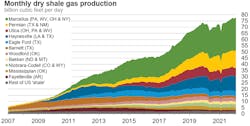For many metalcasting operations the cost of natural gas has more than doubled over the past year. Should you get used to these higher prices? Let’s try to answer that question by exploring some of the factors that affect the natural gas market.
If your foundry is set up on a fixed-rate supply contract for natural gas, you may not have noticed the increased costs. And you’ve probably gotten some significant savings during the past year or more. But even those currently on supply contracts need to be aware of increasing prices when they shop for their next supply contract. So, why the increases?Let’s focus on several major sources of demand for natural gas and the current supply situation.
Electric Generation – In 2020, the electric power sector accounted for about 38% of total U.S. natural-gas consumption. According to the federal Energy Information Administration (EIA), this sector consumed the most amount of gas during 2020 (11.62 trillion cubic feet.) I expect this to continue (and increase), as we retire more coal-fired electric generation plants.
Exports – Our natural-gas supply is now part of a global commodities market. We can convert and compress regular natural gas into liquified natural gas (LNG) and transport it anywhere in the world via special LNG tankers. We began exporting LNG in 2016. Last year, those facilities exported over 12% of our annual natural-gas supply (approximately 9.7 BCF per day.) The LNG facilities now operate at close to 100% capacity. Additional facilities have been approved, but these take several years to build and commission. Once built, these facilities will produce approximately 25 BCF per day, for a total output of almost 35 BCF per day.
In addition to the LNG market, in 2021 several natural gas pipelines exported over 3% of our gas to Mexico. The combination of the LNG and Mexican markets accounted for almost 12 BCF of natural-gas consumption during 2021, or 15% of total consumption.
Last year over half of our natural gas was used to produce electricity in the U.S. or was exported to other countries. This can have a significant impact on the future price of natural gas, but don’t we have enough gas to keep those prices low? Maybe not.Monthly Gas Production – Shale natural-gas production accounts for most of the natural gas that we use. Shale-gas production during 2021 averaged 77 billion cubic feet (BCF) per day.
Natural gas can be stored for future use. It is pumped into underground storage sites and retrieved when needed. A 12-month cycle of injection and withdrawal has been in operation for many years.
Such storage is essential to meet heating needs during the winter and peak electric generation during the summer. It is vital that our natural gas storage fields get replenished during the injection seasons of late Spring through early Fall. Many factors affect those levels, including national weather patterns.
If we don’t have enough gas in storage, available for immediate use, price volatility increases.
Market Price – Market prices usually give an accurate representation of the balance between supply and demand, fluctuating to reflect the dynamic changes in this complex marketplace. And those prices can change rapidly and dramatically. We now see prices trending higher in both spot and futures prices.
Impacts – Don’t count on natural gas prices dropping any time soon. TradingEconomics.com forecast sees natural gas trading at $6.00 per million Btu by the end of Q2 2022, and rising up to $6.92 by April 2023. These are wholesale prices. Prices quoted for retail contracts will be higher.
If you operate in an area where you can shop for natural gas supply, you should review your procurement strategy to lock in lower prices now. Existing contracts often can be modified with “blend and extend” options from the supplier. Click here to see if you can shop for natural gas supply to get lower costs.
Rising natural-gas prices also can affect future electricity prices in many areas. Virtually all electric utilities are now allowed to pass along fuel costs to their customers, so actual electricity costs also may increase. Check here to see if you can shop for electric supply to get lower rates.
Surprisingly, some futures prices for electricity have not risen as fast. You may still find rates per kWh that are lower for 2024 and beyond, so it’s worthwhile to review new electric supply proposals: Some suppliers are offering contracts for up to five years.
If you would like no-obligation quotes from multiple suppliers of gas and/or electric supply, please contact us today. See how good supply contracts can reduce your risk exposure to rising gas and electric costs.
Brian Reinke, president of TDI Consulting, is an energy-cost saving consultant. Contact him at [email protected].
About the Author
Brian Reinke
President
Brian Reinke, president of TDI Energy Solutions, is an energy-cost saving consultant. Contact him at 630-343-0971.


